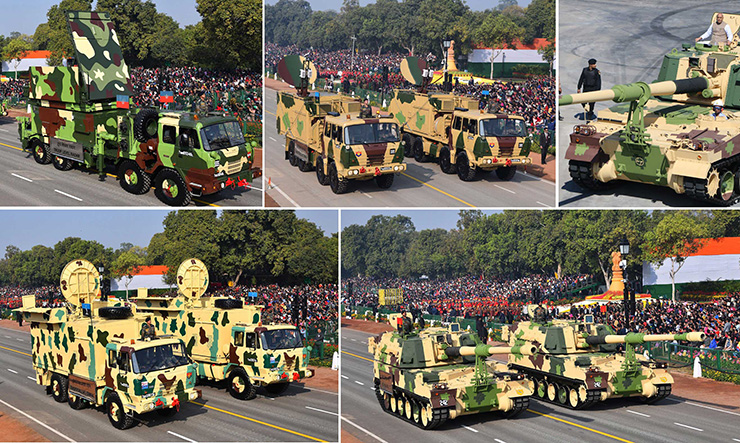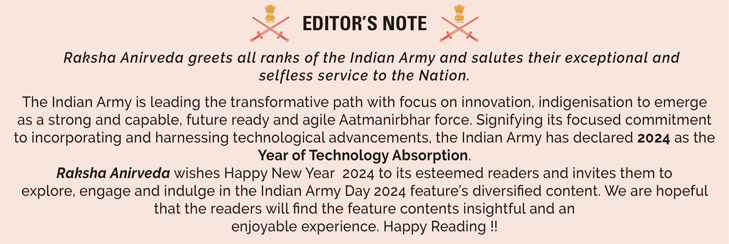
All nation-states have traditionally evolved to peacefully coexist amongst the comity of nations. However, ideological differences and internal strife necessitates a strong and effective military that needs to update and be current in strategy, tactics and technology. In the Indian context, its military has evolved over time and has earned the distinction of being one of the most modern, robust and experienced Armed forces with a strength of over 1.4 million active personnel, ranked as the world’s second-largest military force with a third-largest defence budget in the world. The Global Firepower Index report lists it as the fourth most-powerful military. This capability stems from the array of core military equipment that are imported from friendly foreign countries besides indigenous development that has been given a fillip in the recent past. In addition, the government’s push to make India self-reliant in defence through its agenda of ‘Make in India’ in the defence sector is a catalyst in itself. Needless to reiterate that a country that is known to have the fifth largest economy in the world cannot afford to be largely dependent on big arms-producing countries, especially in critical defence systems.
Ironically, the dynamics of recent wars have espoused the shift of military conflict from a short sharp engagement towards long drawn protracted war spanning several months or years. Thus, the sustainability quotient for such protracted engagement has to have a robust defence manufacturing capability to ensure that the powder doesn’t go dry. In addition, this war along with several skirmishes around the globe, has upended the global arms industry which remains largely aligned with global geopolitical linkages. In fact, so far as India is concerned, the Ukraine war is a stark reminder of the urgent need to reduce dependence on foreign suppliers. This dichotomy of self-sufficiency vis a vis self-reliance remains the crux of the policy framework in indigenous defence manufacturing.
Process of being Self-Reliant in Defence
To be self-reliant in defence, India requires a conducive ecosystem backed by a sound and adequate infrastructure for the industry to be attracted to investment. This will stem from the fact that the government remains the sole customer to keep the demand afloat so as to ensure the viability of the industry and ensure long-term sustenance. Whereas in practical terms the “demand factor” is based on defence “capability maintenance” to start with and subsequently moving on to “capability development”. The former is a mandated budgetary necessity to ensure the nation’s peace and stability while the latter is a policy-driven budgetary allocation. Thus, to keep the demand buoyant the country has to embark on a liberal policy framework of allowing multinational arms companies to make India their production base and an export hub. In addition, a vibrant and collaborative R&D base would further this agenda.
Indian Initiative towards Self-Reliance
In line with this thought process the efforts made to boost the defence industry during the last few years have turned India into a significant manufacturer and an exporter of defence systems. The agreement to supply highly advanced BRAHMOS supersonic cruise missiles to the Philippines has given a big boost to the Indian arms industry. Thus, India’s defence exports, which were worth a meagre Rs 900 crore eight years ago, have now touched a record Rs 14,000 crore. The recent US decision to permit 100 per cent transfer of GE-414 engine technology to India under the iCET (initiative for critical and emerging technology) agreement is an example of Indian diplomatic efforts to bring high technology to India, enabling India to be self-reliant in weapon systems and platforms like the Light Combat Aircraft (LCA). It will also boost India’s own advanced fifth-generation fighter project AMCA.
The HAL Advanced Medium Combat Aircraft (AMCA) is an Indian programme to develop fifth-generation stealth, multirole combat aircraft for the Indian Air Force and the Indian Navy which will include sixth-generation technologies powered by the American GE-414 engines in the 98 Kilonewton thrust class, like the Tejas Mark-2 jets. Besides this, the collaboration with the French defence industry supports the joint development of a combat aircraft engine. A roadmap to this effect is being prepared between the French company Safran and the Defence Research and Development Organisation (DRDO) besides supporting industrial cooperation for the motorisation of heavy-lift helicopters under the Indian Multi-Role Helicopter [IMRH] programme with Safran Helicopter Engine.
Similarly, the recent MoU signed between India and France to fabricate submarine and surface combatants and parts for export will boost the “Make in India” initiative allowing Mazagon Dockyards Limited to jointly develop and manufacture Scorpene class submarines with French Naval Group for a third country, based on the success of the first Scorpene submarine construction programme (P75 – Kalvari). These Submarines are extremely potent platforms, with advanced stealth features and equipped with both long-range guided torpedoes as well as anti-ship missiles and state-of-the-art SONAR suite and sensor suite permitting outstanding operational capabilities. In addition, the agreement signed between Garden Reach Shipbuilders and Engineers Ltd (GRSE), and Naval Group France, a leader in the European Naval Defence Industry to collaborate in the field of surface ships will eventually meet the demands of Indian and International Naval forces.
Government’s policy initiatives
The Government has taken several policy initiatives in the past few years and brought in reforms to encourage industrial viability through indigenous design, development and manufacture of defence equipment, thereby promoting self-reliance in defence manufacturing & technology in the country. These initiatives, inter-alia, include according priority to procurement of capital items of Buy Indian (IDDM) category from domestic sources under Defence Acquisition Procedure (DAP)-2020; Notification of four ‘Positive Indigenisation Lists’ of total 411 items of Services and three ‘Positive Indigenisation Lists’ of total 3,738 items of Defence Public Sector Undertakings (DPSUs), for which there would be an embargo on the import beyond the timelines indicated against them; Simplification of Industrial licensing process with longer validity period; Liberalisation of Foreign Direct Investment (FDI) policy allowing 74 per cent FDI under automatic route; Simplification of Make Procedure; Launch of Mission Def Space; Launch of Innovations for Defence Excellence (iDEX) scheme by involving Start-ups & Micro, Small and Medium Enterprises (MSMEs); Implementation of Public Procurement (Preference to Make in India) Order 2017; Launch of an indigenisation portal namely SRIJAN to facilitate indigenisation by Indian Industry including MSMEs; Reforms in Offset policy with thrust on attracting investment and Transfer of Technology for Defence manufacturing by assigning higher multipliers; and Establishment of two Defence Industrial Corridors, one each in Uttar Pradesh and Tamil Nadu; Earmarking of 25 per cent of R&D Budget for Industry led R&D; Progressive increase in allocation of Defence Budget of military modernisation for procurement from domestic sources, etc.
India’s defence industry Strength
We need to be proud that India’s defence industry is now capable of manufacturing a wide variety of high-end requirements e.g., tanks, armoured vehicles, fighter aircraft, helicopters, warships, submarines, missiles, electronic equipment, special alloys, special purpose steels, and variety of ammunition. Rapid progress has been made towards achieving self-sufficiency in defence equipment already in service with our armed forces.
As a result of these initiatives, many State-of-the-art products including 155 mm Artillery Gun system ‘Dhanush’, Light Combat Aircraft ‘Tejas’, Surface to Air Missile system ‘Akash’, Main Battle Tank ‘Arjun’, T-90 Tank, T-72 Tank, Armoured Personnel Carrier ‘BMP-II/IIK’, Su-30 MK1, Cheetah Helicopter, Advanced Light Helicopter, Dornier Do-228, High Mobility Trucks, INS Kalvari, INS Khanderi, INS Chennai, Anti-Submarine Warfare Corvette (ASWC), Arjun Armoured Repair and Recovery Vehicle, Bridge Laying Tank, Bi-Modular Charge System (BMCS) for 155 mm Ammunition, Medium Bullet Proof Vehicle (MBPV), Weapon Locating Radar (WLR), Integrated Air Command and Control System (IACCS), Software Defined Radios (SDR), Lakshya Parachute for Pilotless Target Aircraft, Opto Electronic Sights for Battle Tanks, Water Jet Fast Attack Craft, Inshore Patrol Vessel, Offshore Patrol Vessel, Fast Interceptor Boat, Landing Craft Utility, 25 T Tugs, etc. have been produced in the country during the last few years. Further, for the first time, a made-in-India Advanced Towed Artillery Gun (ATAG) howitzer gun developed by our industry was part of the 21-gun salute during the Independence Day celebration at Red Fort in Delhi.
In conclusion, while these initiatives speak for themselves the bottom line is the need to continuously address the “demand factor”. This has to be made possible by creating a steady domestic defence consumption and leveraging the global market in defence. In order to do this the concept of demand pull has to be developed based on domestic threat assessment and foreign policy framework. Thus, to keep the demand buoyant the country has to innovate ease of doing business thereby attracting multinational arms companies to make in India.
–The writer is a former GOC-Indian Army and presently a Strategic Consultant, Principal Advisor. Views expressed are personal and do not necessarily reflect the views of Raksha Anirveda











